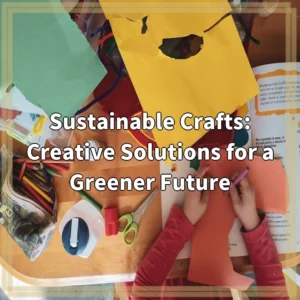What It Is:
Crafting a Sustainable Future: Inspiring Eco-Friendly Creations is a blog that explores the concept of sustainable crafts. It focuses on various crafting practices that prioritize environmental conservation, waste reduction, and the use of eco-friendly materials.
Real-World Problems:
Sustainable crafts address several pressing environmental issues and aim to mitigate their impacts. Here are a few key problems that this blog will explore:
1. Excessive Waste Generation:
Traditional crafting often generates a significant amount of waste, including single-use materials, packaging, and leftover scraps. These materials contribute to landfills, pollution, and resource depletion. Sustainable crafts aim to minimize waste by utilizing recycled materials, repurposing items, and implementing careful material management techniques.
2. Harmful Materials and Chemicals:
Many conventional crafting materials contain harmful chemicals, such as toxic dyes and adhesives, which can have adverse effects on human health and the environment. Sustainable crafters prioritize the use of eco-friendly and non-toxic alternatives, such as natural dyes, water-based adhesives, and organic fabrics.
3. Deforestation and Habitat Destruction:
The production of certain crafting materials, such as wood and paper, can contribute to deforestation and habitat destruction. This blog will explore sustainable alternatives, such as using reclaimed wood or opting for plant-based fibers that have a lower environmental impact.
4. High Energy Consumption:
Some crafting techniques and equipment, like electric kilns or large-scale printing processes, consume a significant amount of energy. Sustainable crafts seek to minimize energy consumption by promoting energy-efficient practices, utilizing renewable energy sources, and encouraging handcrafting techniques that reduce reliance on power-driven equipment.
5. Carbon Footprint of Supply Chains:
Crafting materials often have complex supply chains that can contribute to greenhouse gas emissions and carbon footprints. Sustainable crafts aim to reduce emissions by sourcing materials locally, supporting fair trade practices, and considering the life cycle impacts of materials from extraction to disposal.

Solutions for Crafting a Sustainable Future: Inspiring Eco-Friendly Creations
1. Waste Reduction:
Sustainable crafters can reduce waste by practicing techniques such as upcycling, repurposing, and using materials that have a lower environmental impact. Emphasizing the principle of “zero waste,” crafters can strive to minimize leftover scraps and prioritize the use of recycled or biodegradable materials.
2. Use of Eco-Friendly Materials:
Choosing eco-friendly materials is an essential step towards sustainability in crafting. This involves opting for organic or natural fibers, water-based and non-toxic adhesives, and dyes free from harmful chemicals. Additionally, sourcing materials locally can help reduce carbon emissions associated with transportation.
3. Responsible Sourcing:
Sustainable crafters can prioritize materials from ethical and environmentally conscious sources. This includes selecting wood from certified sustainable forests, supporting fair trade practices, and using materials made from recycled or reclaimed sources.
4. Energy-Efficient Practices:
Incorporating energy-saving techniques, such as handcrafting or utilizing renewable energy sources, can significantly reduce the carbon footprint of crafting. Additionally, using energy-efficient equipment and optimizing processes can help minimize energy consumption during the creation of sustainable crafts.
5. Education and Awareness:
Raising awareness about sustainable crafting and its benefits is essential for driving change. By educating crafters and consumers about the environmental impacts of traditional crafting practices and the alternatives available, more people can make informed decisions and actively contribute to a sustainable future.













